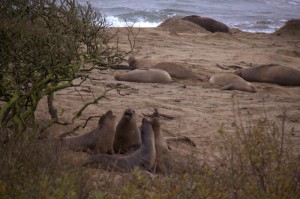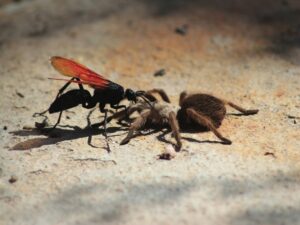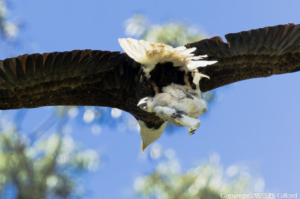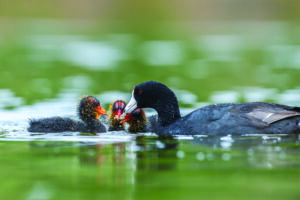Resting patiently in a coma-like state, the alpha bull’s heart slows to 12 beats per minute as he conserves his energy for the violent spars soon to unfold along the sandy shores of Año Nuevo State Park. Awaiting the arrival of fertile females, the alpha must continuously stake out his territory, foregoing food and drink for months for fear that he will be dethroned as “beachmaster” in his absence.
Born to breed, the life of the elephant seal revolves around a four month window beginning each December, a time when males and females crowd on beaches along the Pacific coast, the battlegrounds of mating and birth. As the world’s largest mainland breeding colony of northern elephant seals, Año Nuevo State Park is beginning to see signs that winter mating has begun. Guided by volunteer docents and State Park Rangers, visitors may catch a glimpse of this dramatic display of procreation until March, when elephant seals embark on a migratory route longer than most other marine mammals.
“This little chance of mating is all they think about, it’s their drive,” says Año Nuevo State Park volunteer docent, Sabine Laus.

After traversing up to 13,000 miles, northern elephant seals arrive each year at their place of birth, one of which is Año Nuevo State Park. The males are first to haul out, slowly claiming their territory through vocal displays and sheer girth. However, as more and more wash ashore, tensions rise and soon battles erupt as males begin to infringe on each other’s mating prospects.
While the bulls duel it out for exclusive breeding rights to a harem, pregnant females roll in one by one, forming aggregates of 50 to 75 individuals. Before mating ensues, females give birth to pups conceived the year prior. Since elephant seals mate only three weeks after giving birth, females have evolved a “delayed implantation” process; a fertilized egg hangs out in the uterus for four months before implanting to ensure the pup will be born at the right time the next winter. Meanwhile, the delay gives the female a chance to to recover from pupping while she nurses her newborn for weeks without eating.
Pride and glory
Only the most experienced of bulls, aged 10 to 12 years, are strong and resilient enough to attain alpha status. The position, bestowed to 10 percent of the male population, allows the alpha to impregnate up to 75 females in one season. But there’s a cost to all that effort.
Alpha bulls have to subsist off their 3.5-inch layers of blubber, metabolizing it for water and nutrition during the four months of mating. Sparring further weakens them. Months spent pounding their calloused chests against other bulls costs the alpha about 12 pounds a day in weight loss. Add to that the excessive mating and many alphas die within a year.
Timing is also everything. Some males arrive well before the females and begin fasting too early. As starvation creeps in, these early birds are unable to last the whole breeding season and must surrender their harems and retreat back into the ocean to feed.
State park ranger Ziad Bawarshi said not all bulls have the personality to vie for the top.
“Some just don’t seem to care, while others are very driven,” said Bawarshi.
But being a lesser male doesn’t mean you’re a complete breeding loser. Although the alphas breed with 90 percent of the females, the other bulls have chances to score. A beta breeder gets the remaining 5-8 percent, while a gamma bull mates with any stragglers.
Breed or bust
Once the pups are born and mating is finished, the females abandon their pups and venture back into the open ocean to bulk up for next year’s mating season. The four-week-old pups are left to their own devices, learning to swim and fish through trial-and-error. Solitary at sea, instinct drives their behavior, and half never make it back to the shores of Año Nuevo.
As the last female departs Año Nuevo’s breeding grounds in March, males plunge back into the ocean, traveling up to the Gulf of Alaska to feed off of bottom-dwelling fish, small sharks, and rays. Weakened from their stark success, most alphas cannot survive the trek and die at sea, opening the door to the betas and gammas. Who will be beachmaster next year? Only the fattest, strongest, loudest and most punctual of bulls.
Don’t miss out on the action. Take a guided tour of the elephant seal colony Año Neuvo State Park in January to see newborn pups and sparring at its best. February also brings a wave of activity, as new mothers begin to mate with alphas. Warning: you must book a tour in advance as spaces fill up quickly. Alternatively, for an unrestricted viewing opportunity, go to an overlook near Chimney Rock at Point Reyes National Seashore.
Coastside State Parks Association and California State Parks are also holding a special fundraising event—Seal Adventures—that allows participants an entire morning or afternoon to observe elephant seals at the peak of the breeding season. Please visit the website to learn more and buy a ticket.
[slideshow]





